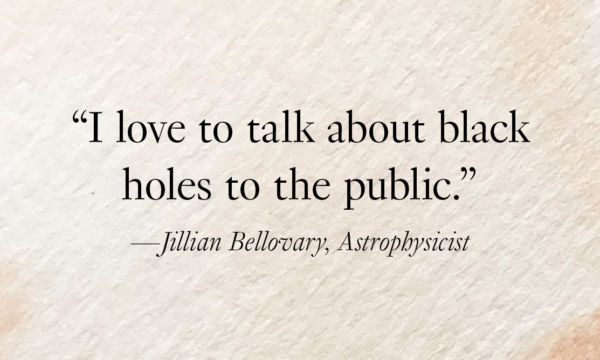So, What Do You Do? Sarah Kloze, Restorationist
April 02, 2019 | Filed in: Your Career
“So, What Do You Do?” is an MM series featuring extraordinary women in the kinds of jobs that make you sit up and say, “What’s that like?” Every week, another original entrepreneur, executive, artist, or scientist will own the answer by sharing what she does, how she does it, and why she does what she does. Up this week, restorationist Sarah Kloze on saving murals, unnecessary drama, and ornamental plaster.
The next time you look up at the ceiling of a handsomely restored library, church, theater, or capitol building to admire the rich plasterwork or the murals, know this: It was somebody’s job to make that look great. If you happen to be in the New York Public Library’s historic Rose Reading Room, for instance, that somebody is Sarah Kloze. The senior project manager joined EverGreene Architectural Arts in 2013, after spending more than a decade working as the Director of Exteriors and Historic Preservation at Columbia University. Before that, she was an architectural conservator and decorative painter.
At EverGreene, Kloze manages more than 100 projects a year, including some of the company’s most prestigious clients (Rainbow Room at Rockefeller Center and Bergdorf Goodman in Manhattan, the Enoch Pratt Library in Baltimore). Among their services: mosaic conservation, mural painting and replication, plaster renovation and conservation, and artifact mounting. Kloze grew up with “community-activist parents who were interested in the built and natural environment, as well as helping people,” she says. In college, she studied urban planning and architecture history. “My professors showed me the importance of neighborhoods, streetscapes, buildings, and art, and the ways that people organized to save them.” In grad school, she got her first jobs in preservation, conservation, and construction, which helped her realize where her skills lay: in identifying the most critical details of a building and in planning and managing the big picture.
Here is just some of what she does in a day:
Marvels at her privilege.
Every project feels like a once-in-a-lifetime opportunity. [I love] working on amazing historic and modern buildings with world-class design and client teams. These buildings are people’s landmarks, people’s memories of visiting New York or another great city. Every time I’m like, ‘Oh my god, I can’t believe I get the chance to work on this!’
Finds the most incredible things during an excavation or renovation.
For example, the Goldwater Memorial Hospital on Roosevelt Island was going to be torn down. The buildings were built in the 1930s or ’40s and different WPA artists had painted murals in some of the waiting rooms. They’d been covered up for decades. Before they tore down the building, New York City’s Public Design Commission decided to rescue them—and that’s where we came in. We used tiny probes throughout the hospital to locate the murals, and then we were able to rescue two out of three of them. It was a painstaking task to pull them from the walls without damaging them. We then took these huge canvases back to the studio. We had no idea how much of the original painting was underneath decades and decades of paint. In the end, we stripped them and found two beautiful abstract WPA murals, fully intact and unique.
Enjoys doing things the old-fashioned way.
[I love to] climb the scaffold and touch the building, and to actually see the spaces and the condition they’re in. We’re big on modern technology—we just had a talk about how valuable photos from a 360-degree camera can be—but, at the end of the day, I still like to climb up to the top and touch the ceiling. You might make assumptions based on a photo, but when you’re on site in person, you get the full story. For instance, with the plaster ceiling of the Rose Reading Room at the New York Public Library, one of the faux metal elements on a shield was so crude that, if I were to take a photo of it, I’d think it was a bad repair. But when you walk back from it, you realize that the artists were so good at faux painting, they understood that this random brush stroke would look like a highlight from 40 feet below.
Searches high and low for great craftspeople.
In World War II, a lot of people got out of the trades. Now, we’re always on the search for great craftspeople. Ornamental plaster, in particular, is a dying trade. There are some guys out there with amazing skills, but they can’t stay busy the whole year doing ornamental jobs alone. So they [supplement that] with flat plaster, acoustic plaster, and some really modern skimming of drywall or sheetrock.
Manages last-minute jobs with aplomb.
Commercial spaces are crazy expedited. We’ll have shifts around the clock and the whole team is designing on the go. We often need to change our plans mid-course. A library might be a three-year, phased project, which is a lot looser than, say, a crazy, high-profile New York City commercial site.
Suggests clever workarounds.
A good example is our mural studio, where we paint things on canvas and install them like wall coverings. People who aren’t familiar with the concept are like, ‘Are you cheap-ing out?’ It does save a lot of site time, which, in turn, saves costs. But it’s also an appropriate method historically. At Enoch Pratt, for example, hundreds of beam faces were stenciled with unique designs. We’re coming up with a group of eight that we’ll mix and spread around so it looks varied. But we’ll be installing on canvas, not painting them directly on the beams. That’s our biggest trick.
Avoids anger, stress, and confrontation.
Those issues are very common in construction—and so not my personality. [I don’t like] to deal with unnecessary drama either in the office or on a construction site. [I like a] happy crew, happy client, efficient processes, and a quality finished product. What gets me stoked is efficiency, teamwork, and awesome designs. There are a lot of fires and squeaky wheels in this field, but sometimes I put them to the side while I complete other tasks. In the end, the big-picture stuff always gets done.
Laughs.
Humor makes me feel better and diffuses drama on a site. I may be with someone I don’t see eye-to-eye with, but if I can make them laugh, I feel like I’ve gotten somewhere.









